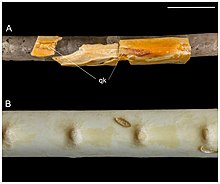Ulna Facts for Kids
The ulna, or ulnar bone, is a long bone in the forearm stretching from the elbow to the wrist.
View Article For:

Related Articles
Introduction
It starts at your elbow and goes all the way to your wrist. The ulna is located on the inner side of your arm when your palms are facing up. It works together with another bone called the radius, which is on the outer side. These bones help you move your wrists and arms. The ulna plays a crucial role in making sure you can bend and straighten your arm and helps you do many fun activities, like throwing a ball or playing catch! 🎾
Anatomy Of The Ulna
It has three main parts: the olecranon, the shaft, and the wrist end. The olecranon is the bumpy part you can feel at your elbow. The shaft is the long middle part, and the wrist end connects to your wrist bones. The ulna is longer than the radius. It grows as you grow, and that helps keep your arms strong! 🥇
Just like a tree grows rings when it gets older, your ulna grows longer as you age. Isn't that cool?
Function Of The Ulna
♂️ It helps you bend your elbow so you can lift your arm, wave hello, or play sports! When you use your arms, the ulna acts like a strong support, connecting to muscles and ligaments. It also helps your wrist move up and down, which is important for writing or playing games. The ulna and radius work together like a team, allowing you to make all kinds of movements with your arms! ⚽
️
Development Of The Ulna
As you grow, your ulna becomes harder and stronger! It starts as cartilage, which is a squishy material. Over time, cartilage turns into bone through a process called ossification. By the time you’re a teenager, your ulna is fully formed! 📅
Kids grow at different rates, but on average, your ulna finishes growing around age 18. That's when your arm is fully developed and ready for adventure! 🚀
Ulna In Different Species
Many mammals, like dogs, cats, and even whales, have this bone in their forelimbs! It helps them in walking, swimming, or even flying. 🐬
In birds, the ulna is shorter, which helps them be light for flying! In some reptiles, like alligators, the ulna helps in moving their thick limbs. So, the ulna is super important not just for us humans, but for lots of other creatures too! 🌍
Common Injuries And Conditions
️ A common injury is called a fracture, which means the bone is broken. This can happen if you fall on your arm. Another condition is called “ulnar nerve entrapment,” where a nerve gets pinched and can make your hand feel tingly! If you ever hurt your ulna, it’s important to tell an adult so they can help. Taking care of your ulna means you can keep playing and having fun! 🩺
Ulna In Relation To The Radius
They live in your forearm and are important for moving your arm and wrist. The ulna is on the inner side, while the radius is on the outer side. When you twist your arm, the radius spins around the ulna! This is why you can rotate your wrist to wave goodbye or turn a doorknob. Together, they make your arm work smoothly, helping you catch a ball or grab a snack! 🍎
Interesting Facts About The Ulna
Did you know that the ulna is longer than the radius in most people? That's why it helps form the elbow joint! 🌈
Also, when you bend your arm, the ulna does a little dance inside your body, allowing it to move smoothly. In ancient times, the ulna was used to measure length and distance, called a “cubit”! 📏
So next time you wave or throw a ball, remember, your ulna is doing a lot of important work!
Surgical Procedures Involving The Ulna
This can involve surgery to help repair fractures or to fix conditions like ulnar nerve problems. During surgery, doctors might use metal plates or screws to hold the ulna together while it heals. This helps the bone grow back strong! After surgery, patients may need to do exercises to regain movement, making sure their ulna is ready for action again! 💪
Ulna And Its Role In The Human Skeleton
It helps form the structure of your arm and connects to other bones to create a complete forearm. It’s important for many movements, like lifting objects, writing, and playing sports. The ulna works closely with the radius to give your arms strength and flexibility. Together, they allow you to perform all kinds of activities – from reaching high on the shelf to playing tag with friends! 🎉
DIY is a humongous library of
activities and courses for kids.
Curious?
Gallery of
Did you know?
🌳 The ulna is one of the long bones in your arm!
🌙 It is shaped like a crescent moon.
🦸♂️ The ulna helps you bend your elbow to lift your arm and wave hello.
👫 The ulna and radius work together like best friends in your forearm.
🌱 Your ulna starts soft and flexible and becomes harder as you grow.
⚠️ A common injury to the ulna is called a fracture, or a broken bone.
🦓 Many animals, like dogs and whales, have an ulna in their forelimbs too!
🏥 Doctors can perform surgery on the ulna if someone gets hurt badly.
🦴 The ulna helps form the structure of your arm and connects to other bones.
🎊 The ulna is longer than the radius in most people, contributing to the elbow joint.




